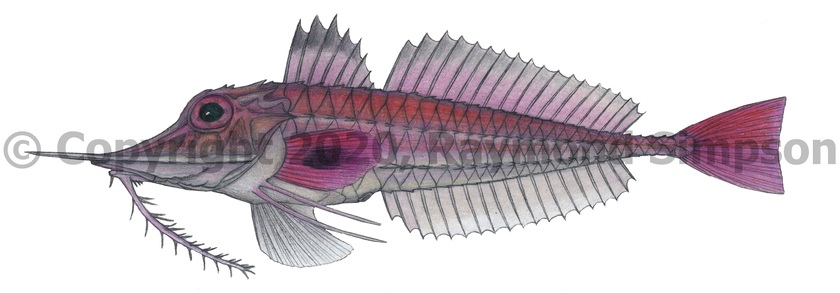
Common Name
Enigma Armored Searobin
Year Described
Miller, 1967
Identification
Dorsal Fin: VIII, 19-20
Anal Fin: 19
Pectoral Fin: 12 + 2 free rays
Gill Rakers: 5+21
Body elongate and flattened ventrally, with four rows of thick, heavy scales forming an armor-like covering. Head wide, tapering gradually rearward. Head with flattened duck-bill snout about the width of eyes and squared-off at tip. Rostral projections long (a little less than snout length), slender, and slightly divergent. Head heavily armored. Edges of snout and head with small spines and undulations. Edge of head not expanded greatly on the cheek, with no strong backward pointing spine on cheek but a noticeable shelf. No spine at nostril. Eye large. Interorbital distance relatively wide. Anterior edge of first body plate posterior to front edge of pelvic girdle. Four lip barbels in two clusters. Chin barbels short; 8-9 in five clusters. Dominant chin barbel long and heavily branched. Dorsal fins separated: the first small and second long-based. Anal fin about the same length as dorsal fin. Pectoral fins small and fan-like with two long free rays that are used to interact/crawl along the seafloor. Pelvic fins small and widely separated under pectoral base. Caudal fin truncate.
Color
Body pale to reddish gray, with darker red markings. Belly whitish. First dorsal fin with a broad dark edge. Second dorsal fin pale with scattered dark spots. A dark spot on the center of the body-colored pectoral fin.
Size
Maximum size to 16cm SL.
Habitat
Found on soft bottoms from 356-530m.
Range
Known from the Straits of Florida and the Bahamas.
References
Miller, G.C. & W.J. Richards. 2003. Peristediidae. Armoured searobins (armoured gurnards). p. 1278-1285. In: K.E. Carpenter (ed.) FAO species identification guide for fishery purposes. The living marine resources of the Western Central Atlantic. Vol. 2: Bony fishes part 1 (Acipenseridae to Grammatidae).
Teague, G.W. 1961. The armored sea-robins of America, a revision of the American species of the family Peristediidae. Anales del Museo Nacional de Historia Natural de Montevideo (Serie 2) v. 7 (no. 2): 1-27, 2 pls. + Pls. 1-3.